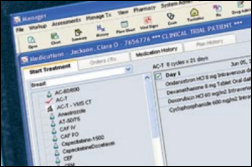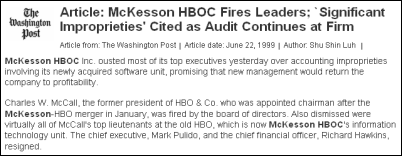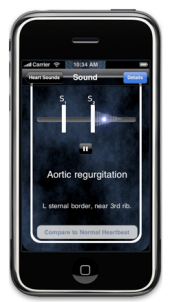The sentence was "most people just go to Epic UGM" - that's people going to Epic's annual user conference and…
News 10/30/09
From HITGhost: “Re: Aspyra. It voluntarily delists itself from NYSE Amex.” The market cap of the LIS/PACS vendor is down to $1.4 million, so obviously it’s not worth the administrative cost to stay publicly traded.
From UKnowMe: “Re: Accenture. I hear that Accenture is eliminating its healthcare practice over the next 2-3 months and will be releasing 300-400 people. Can anyone confirm?” I haven’t heard that, but Accenture just launched the Center for Health. I never know what a company or university means when it announces a “center” that doesn’t seem to involve new people, new facilities, or anything more than a new marketing campaign and maybe a new suit or two, but it happens all the time. Here’s another one: IBM is opening a Health Analytics Solution Center in Dallas, which one of its people says is related to Dell’s Perot acquisition.
From Weird News Andy: “Re: brain surgery. Being in Britain, the patients did not have to pay through the nose for this procedure.” Surgeons are removing skull base tumors through the nose, with one patient leaving the hospital just to days later. Just in case this doesn’t impress, the newspaper article gives a graphic description of the alternative: “Previously, neurosurgeons would have had to split the facial skeleton or peel back the scalp and remove the skull on the forehead to complete the same operation.”
Athenahealth reports Q3 numbers: revenue up 37% to $49 million, EPS $0.14 vs. $0.14, missing expectations of $0.16.
In Britain, a member of Parliament wants to know the cost of iSoft Lorenzo at early adopter sites, saying the number could run anywhere from hundreds of thousands to even millions of pounds per concurrent user. Richard Bacon says Lorenzo isn’t providing value and Cerner Millennium “has caused absolute havoc.” On the other hand, the arguments seems largely political.
HIMSS continues its acquisition of other member groups, this time taking over the Medical Banking Project (HIMSS always calls it “unification with” the group it takes over). Its membership is a bit company-heavy with 163 individuals and 42 corporate members. The only employee mentioned is its founder, from whose home in Franklin, TN it is apparently run. I could find only one reference that called it a non-profit, with its own materials describing it as “a self-funded policy research firm.”
CHIME awards Ivo Nelson, chairman of Encore Health Resources, its Lifetime Achievement Award. I couldn’t find a link for the press release that someone sent me.
A radiation oncologist says Varian’s linear accelerator sales should increase in an economic recovery, but its clunky ARIA oncology EMR is a dog that might hold it back. In his words, “ARIA is far too complex and does none of the simple everyday tasks well. Obviously written by an engineer with little clinical input from the end users, ARIA is a major physician dissatisfier, as they find daily tasks much more time consuming.” Just what you want your doctor to be struggling with as they’re treating you for cancer. If you agree with his opinion, that is.
In all the Charlie McCall talk, I shamefully neglected to observe the October 18 11-year anniversary of the announcement that McKesson was buying HBOC. I editorialized about his first trial back in 2006, with this shout-out to the neglected McKesson shareholders who got burned the worst: “Among those involved were certainly some crooks and some fools, but let’s not forget those who suffered most, those McKesson lifers who had stashed away years’ worth of shares of their unexciting company’s stock instead of risking it on flaky enterprises like Microsoft and Dell. When lonely old conservative widower Dad McKesson brought home a sexy young step-mom named HBOC, she stole the kids’ piggybank.”
Cerner announces Q3 numbers: revenue down 3%, EPS $0.57 vs. $0.54, falling short of revenue estimates. System sales were down 14% and global revenue was down 23%. CERN also guided down on Q4 revenue. Neal actually chimed in at the end of the conference call.
A little recognition for HIStalk’s Founding Sponsors: Medicity and Nuance. Medicity has started a rather cool HIE Blog, I notice, that unlike the usually crappy corporate “blogs” that have “posts” written by chipper marketing types that don’t even claim to be written by executives, Medicity’s is the real deal. Included are posts from one of the smartest people I know in the biz, Robert Connely. Both companies (eScription, in the case of Nuance) were among the sponsors of HIStalk back when I was writing it with a chisel on stone, so I ought to thank them a little more often.
Allscripts used to own the domain escripts.com but let it lapse, so it went up for auction this week. There were no takers at the expected range of $10-25K. On the other hand, medicalpractice.com went for $9,000, conciergedoctor.com fetched $1,250, and h1n1fluvaccines.com was bought for $1,000.
I e-mailed the Canadian medical device licensing people about classifying EMRs as regulated devices. I appreciate this response:
In general, but not necessarily inclusive, patient management software is any software that is intended to be used to diagnose, treat, mitigate or prevent a disease, disorder or abnormal physical state, or its symptoms, in a human being. Please be advised that the classification of patient management software as a medical device and the requirement for licensing is not a new approach taken by Health Canada. Manufacturers have always been responsible to undertake their own due diligence to determine regulatory requirements. Health Canada has considered software of this nature a medical device for several years. Health Canada did not create the notice regarding patient management software with specific ‘information systems’ in mind. It has always been Health Canada’s role to review medical devices to assess their safety, effectiveness and quality before being authorized for sale in Canada.
According to the US FDA’s interpretation, a medical device is “intended for use in the diagnosis of disease or other conditions, or in the cure, mitigation, treatment, or prevention of disease, in man or other animals.” It almost sounds like software vendors in Canada recognized their own products as medical devices and had them evaluated as such, but US vendors have staunchly argued that their products aren’t covered. Software that displays or manipulates lab results, provides diagnostic suggestions, or manages drug therapy seems to fall into the broad category as laid out by FDA.
Ten software developers in Rwanda who work on the OpenMRS EMR graduate from an 11-month course called e-Health Software Development and Implementation, part of the country’s effort to transform itself into an IT hub.
The Center for Connected Health and Mass General buy a Tandberg telepresence videoconferencing system for telemedicine. I thought they dealt more with home medical sensors and monitoring, but maybe the mission has changed.
A med student and his programming partner (isn’t that who always creates medical apps?) develop iMurmur, an iPhone-based learning tool for heart murmur. It has sold 15,000 copies to users in 35 countries, pushing its price from 99 cents to $2.99 and leading to its acquisition by a digital stethoscope company.
The King of Jordan hosts hosts a public demo of its VistA system, implemented by Perot and the non-profit Electronic Health Solutions. Jordan is creating a VistA educational program to make itself self-sustainable.
Jobs: Director of Business Development, Clinical Application Educators, Cerner Remote PathNet Support.
Half of the doctors responding to a British survey say they are too busy typing into the computer to look patients in the eye. One doctor said, “The demands of the patient’s agenda, the Government’s agenda and the requirement that everything I hear, say and do must be meticulously recorded make for an extremely crowded consultation.”
John at Chilmark Research finds interesting facts about the Dossia PHR. After they parted ways with Omnimedix and hooked up with the Indivo platform from Children’s Boston, they found that Indivo wouldn’t scale, so they had to rewrite it. John outlines other problems they’re having. One I’ll add is that PHRs aren’t exactly lighting up the skies and Google and Microsoft are formidable competitors for what little interest there is.
Odd lawsuit: welfare recipients in Michigan file a class action lawsuit against the state for not paying for adult dental benefits. The state is broke, of course.
Also going broke: California, which paid $2.1 billion in overtime to state employees last year. One state hospital nurse made $733K in overtime in a five-year period, while two other nurses at the same hospital made $132K each per year, twice their annual salary.
HERtalk by Inga
The US Postal Service finds CalOptima’s missing CDs that contained unencrypted personal data on 68,000 members. The package landed in a secure postal facility in Atlanta and the disks appear to be intact.
GE Healthcare’s Medical Quality Improvement Consortium (MQIC) is submitting anonymous clinical data to the CDC to provide H1N1 tracking information. MQIC is a repository of de-identified clinical data captured from GE’s Centricity EMR users. Every 24 hours, MQIC is forwarding updated data that’s been collected from 14 million record patient records. Great use of EMR data, though I wonder if the patients (and/or providers) are aware their de-identified clinical data is being used for this purpose. Or if they need to know.
Would you be more willing to travel to Thailand for surgery if you knew the hospital was using Microsoft HealthVault to document your treatment? Me neither. Hospital officials at the Bumrungrad International Hospital in Bangkok seem to think it will add to their appeal. I believe the $5,000 knee replacement that would cost $50,000 at home is still the bigger draw.
St. Paul Eye Clinic (MN) selects SRS EMR for its 15-provider group.
API Healthcare announces that seven new hospitals have signed on for its human capital management solutions.
El Camino Hospital (CA) deploys Web performance monitoring solutions from Gomez, Inc. The performance and availability monitoring applications will concentrate on El Camino’s recently launched public Web site and its physician application site.
Ingenious Med reports that nine new organizations have added its inpatient practice management system over the last three months.
I love my iPhone, so I was not surprised to learn that 99% of all iPhone users are happy with their smart phones. In fact, we are two times more likely than BlackBerry users to say we are very satisfied. I’m not sure I can think of any other consumer product with a 99% satisfaction rating.
Speaking of iPhones, Harvard Medical School launches an application to update consumers with the latest H1N1 flu virus news, including tips for shaking hands or other body parts to avoid the spread of virus. (Do people seriously do this?)
One last iPhone comment: here’s a nice list of healthcare applications, complete with product summaries and pricing.
GE expands its healthymagination campaign, launching a new e-health business unit that is focused on connectivity among providers, hospitals, and patients. While the announcement suggests that GE is jumping into a brand new world, the core products sound familiar: LifeSensor PHR, Centricity HIE, a clinical portal, and master patient index technology. I guess GE wasn’t too concerned over the use of “eHealth”, even though the folks in Ontario sort of sleazed up the name.
Allina Hospitals collaborates with CVS’s MinuteClinics to align clinical care operations and medical oversight. Allina and MinuteClinic will also develop interfaces between their two EMR systems.
Regional Medical Center Anniston (AL) selects ProVation MD software for cardiology procedure documentation and coding.
A Florida man opens his mailbox and finds an envelope containing medical records of over 70 people. The full chain of events is unclear, though a postal employee or two seem partly at fault. Just a reminder that while we might one day have fully secure EMRs, we’ll never rid the world of stupid (lazy?) people.












I went to school with the King of Jordan (for one year). Bet MrHISTalk cant say that!
Here’s a link to Encore’ press release for Ivo’s award… http://www.encorehealthresources.com/node/66
Still waiting for CHIME’s to be posted.
On the Bumgrungrad Hospital, I took time out with my cell phone and created a live video interview with the CEO and a representative from Microsoft Health Services. Amazing what you can do with cell phones today. I also spent some time at the Worldwide Tourism conference picking some international brains and will report some of that soon. Who would have ever thought that we would see hospital and surgery marketing balloon to what we are seeing today, here and overseas.
http://ducknetweb.blogspot.com/2009/10/interview-with-curtis-schroeder-ceo.html
the link for the iPhone healthcare apps appears to be broken.
(From Inga:Here you go. http://www.informationweek.com/news/healthcare/leadership/showArticle.jhtml?articleID=220900375. )
**Neal actually chimed in at the end of the conference call. **
He sounded nervous, to say the least. Did the conference call mention the letter he received from Senator Grassley? Do you think he notified the SEC and the shareholders of what appears to be the start of a detailed investigation?
[From Mr. HIStalk] Sean Wieland from Piper Jaffray asked about it right away. Marc Naughton’s response:
Hi, Matt… how you been? Bet you didn’t know I read this rag, did you?
الملك عبد الله الثاني بن الحسين
“We view the committees interest and HIT is becoming embedded kind of in the dialogue around healthcare policy and reform so we look forward to working with the committee and providing requested information and working with them as needed, so we don’t see it impacting our near term business and I think that it’s something that the government is doing their job and we fully look forward to complying with any requests.” Marc Naughton, as reported above.
Does any one understand one word of what he is saying?
Does anyone understand one word of what Neal said on his “chime”?
The problems that have been reported with HIT systems in the UK and Australia may be due to the same cognitive capacity witnessed in these statements to shareholders and analysts.
“The government is making a large investment in healthcare information technology so it kind of makes sense for them to fully understand what that investment is going to be related to.”
excuse me.
Kind of?
First, thanks Mr HIS talk to the post I wrote on Dossia. Agree, by and large PHRs are not exactly lighting up the HIT space. Main reason is that most consumers want to conduct transactions and not just have a digital, typically bolted to the floor (non-portable) PHR, consumers want transactions, thus the success of KP’s MyChart and Group Health’s as well. I inferred such in the post on Dossia.
Second, the folks at Accenture here in Boston have told me there has been some major realignment to build-out their HC services grp so doubt anything is shutting down.
I agree, “software that displays or manipulates lab results, provides diagnostic suggestions, or manages drug therapy,” falls under the FDA’s definition of a medical device. Furthermore, the sophisticated ways in which labs now use middleware and LIS functionality will likely encourage more regulation. For example, the increased amount of automated functions being performed by clinical laboratory data management software, such as auto verification, illustrate how both laboratory middleware and laboratory information systems impact patient safety every bit as much as an FDA-regulated laboratory instrument that is used to initially produce a result.
Given that poorly designed and supported software has the potential to harm a patient, steps must be taken to ensure manufacturers develop and service these applications with quality patient care and safety if mind. Vendors must to adhere to best practices including strict design control, process evaluation, risk management, hazard analysis, and continuous quality improvement. These manufacturing and support systems are exactly what the FDA seeks to regulate, and such regulation is in the best interest of the consumer. In fact, our company believes this so strongly we became the first and only middleware device company to receive both a 510(k) clearance from the FDA and a Class II Medical Device Licensure from Health Canada.
http://www.datainnovations.com/